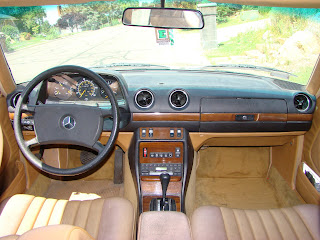
August 27, 2008
What is this?

August 23, 2008
Road test: 2008 smart fortwo.

The original smart car was met with both admiration and skepticism. Some called it too expensive, some called it ugly and some thought it was the best thing to hit the streets of big European cities. The smart ended up being a hit, enough so that they wanted to create a brand around it. The little two seater was rebaptized the fortwo while the roadster and the forfour (that seats five) made their appearances in showrooms, all under the smart moniker. The roadster and the forfour were phased out fairly quickly, a real shame when you consider the driving pleasure the roadster has to offer. The lisence to build it was sold to Chinese-owned MG.
This left the little fortwo. At one point, whether or not it would be replaced was up in the air, there was talk of killing the smart brand. They decided to keep it around and redesigned it. This car is a huge hit in big cities and as of now, the smart has no direct competitor, surely that was a big incentive in keeping it around. It's worth noting that Toyota has a smart rival in the works, one they call the IQ, not a horribly original name..
I hopped in my 300D and trekked out to Mercedes-Benz of Lindon. I found a showroom with no sales people. I went up front and asked for assistance, they sent a guy over who directed me to the "smart lady, she's really smart." Nice pun.





August 20, 2008
Early Turbo.

At the time of writing, I own nine cars. I could cause my own traffic jam if I wanted to. But, it hasn't always been this way. In early 2005, I only owned two! Both of them Alfas (1966 GTV and 1988 Milano Verde), both of them are still part of my fleet today and neither of them run.
Needs work on power steering and bearings"




August 18, 2008
356.
Before the Civic.




August 12, 2008
Changing the fuel filters on a 300D.

Since the week I bought the car, I have had both the main fuel filter and the pre-filter bouncing around the rear footwells of the car. I turn, they turn too, it's all fun and games until I hit a hill and the car essentially goes nowhere. Clearly the hour to change the filters had rang. So I naturally put it off for a bit. I got around to it this morning, it's a fairly simple job.

Unscrew the ring, take the filter out, put your finger on the end of the line and quickly put the end of the new filter in there. Set the old filter down above the headlight. Realize it's leaking diesel and toss it on the ground where it will continue to leak. Make sure the new filter is in all the way and tighten the ring. Repeat the process for the other end of the line.

That said, you might be tempted to grab your oil filter wrench and attack it. That would not do much good. On the photo above, look at where my key is pointing-- that's the bolt that holds it in. Now, as much as I'd like to tell you what size that is, I have no idea. It's larger than a 19mm, I didn't have anything larger on hand and didn't fancy digging through my garage to find one so I used an adjustable wrench, worked fine.
Undo the bolt, you'll see the filter slowly start to drop. This is full of diesel and, much like the last one, will leak. Let it leak onto the pavement for a bit until you decide to use the roll of paper towels you brought down for this very purpose.
Once the top bolt is loose you can unscrew the filter. Toss it next to pre-filter where they will leak in harmony, nicely complementing the oil stains from your valve cover gasket.
Now that the filter is off it gets interesting. You need to prime the car because air gets into the injection system. The injection pump has a little knob that you use to prime it. Alternatively, Ian told me of a way that involves cracking open the injector lines until gas comes out.
I did none of that. I filled the main filter with diesel until it was almost to the top, screwed it back on, tightened the bolt. Then I got in the car and cranked it until it started. And it did. And it died. So I cranked it again until it started, this time it started faster and ran fine, albeit with a shoddy idle, my treat every morning when I start it up.
Make sure everything is tight and that you haven't left any diesel-soaked paper towels in the engine bay, close the hood and start the car. Drive it around to see how it runs. While you're driving, you'll notice a mighty diesel smell. You'll likely worry about that diesel smell, you might even be tempted to turn the car off until you realize it comes from your hands. Park it, open the hood and inspect for leaks. If it all checks out okay, go inside and take a shower.
August 11, 2008
499,628.
August 1, 2008
Road test: 1984 Mercedes-Benz 300D.

Last December, I posted a road test of my old 1979 300D. The test ended along the lines of "if you want a daily driver, get one with a manual transmission or get one with a turbo."





